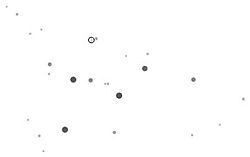Cassiopeia mu star
| Cassiopeia mu star A / B Mu Cassiopeiae A / B | |
|---|---|
| Constellation | Cassiopeia |
| Apparent magnitude (V) | 5.3 / 10.7[1] |
| Variable star type | Ignorance (Suspected) |
| An orbital element and property | |
| Orbit semimajor axis (a) | 0.186″[1] |
| Eccentricity (e) | 0.61[1] |
| Revolution period (P) | 21.43 A year [1] |
| Orbit angle of inclination (i) | 110.0°[2] |
| Ascending node celestial longitude (Ω) | 227.3°[2] |
| The last time perigee passage | 1975.80 |
| Position Epoch: J2000.0 | |
| Right ascension (RA,α) | 01h 08m 16.39470s [3] |
| Declination (Dec,δ) | + 54° 55′ 13.2264″[3] |
| Radial velocity (Rv) | -98.1km/s [3] |
| Proper motion (μ) | Right ascension: 3,422.23 millisecond / year [3] Declination: -1,598.93 millisecond / year [3] |
| Annual parallax (π) | 132.38 +-0.82 milliseconds [3] |
| Distance | 24.6 ± 0.1 Light-year (7.54 ± 0.03 Parsec) |
| Absolute magnitude (MV) | 5.78 / 12 |
 | |
| A celestial map of Cassiopeia. The star which I circled is a mu star. | |
| Physical property | |
| Radius | 0.791 [4] / 0.29 R☉ |
| Mass | 0.74 / 0.17 M☉[5] |
| Spectral class | G5 VIp / M5 VI |
| The intensity of light | 0.442 [4] / 0.001L☉ |
| Surface temperature | 5,297 [4] K |
| Color index (B-V) | 0.69 |
| Color index (U-B) | 0.07 |
| Quantity of metal [Fe/H] | 13-28% (the sun ratio) |
| Age | 7.9 X 109 years |
| The other name | |
| The other name | |
| ■Template (■ notebook ■ commentary )■ Project | |
The Cassiopeia mu star (Cassiopeia ざ mu result, μCas, Mu Cas, Mu Cassiopeiae) exists in the binary that there is in Cassiopeia at the position 24.6 light-year away from the sun.
Summary
On the constellation, Cassiopeia theta stars form a line other than a subordinate star near, and even a nickname called マルファク is called it in conjunction with a mu star. But, in the theta star, there is not is gravitational to be in the distant place more than 100 light-year, being connected and is the apparent double star which is only seen in the by chance same direction judging from the solar system. The name マルファク comes from Al マルフィク (Al Marfik) of Arabic to mean "an elbow" or Al Mirfak (Al Mirfaq) [6].
The existence of the subordinate star which was not distinguished was confirmed in the photograph, and, from the result that analyzed a photograph for the past 23 years in 1961, it was found that it was binary by a change of the proper motion [7]. Two fixed stars are known to revolve now in the elliptic orbit where distance fluctuates from 3.3AU to 11.9AU. As for the mass, solar 0.74 times, subordinate star have all a smaller main star with around 0.17 times than the sun. In addition, because it travels the galaxy at comparative high speed of 167km/s, I am seen with a fixed star of family II where there is little old times metal quantity born before that a galactic disk is formed and am classified in the subdwarf which is a high temperature smaller than a general main sequence star.
References
- ^ a b c d Malkov, O.Yu.; et al. (2012-10), "Dynamical masses of a selected sample of orbital binaries," it is A69, Bibcode 2012A&A Astronomy and Astrophysics 546...546A..69M, doi: 10.1051/0004-6361/201219774
- ^ a b Heintz, Wulff D.; Cantor, Bruce A. (1994), "An Astrometric Study of Four Binary Stars," it is 363–364, Bibcode 1994PASP..106..363H, doi: Publications of the Astronomical Society of the Pacific 106 10.1086/133386
- ^ a b c d e f "mu. Cas - - Spectroscopic binary". SIMBAD. December 28, 2016 reading.
- ^ a b c Boyajian, Tabetha S.; et al. (2008-08-10), "Angular Diameters of the G SubdwarfμCassiopeiae A and the K DwarfsσDraconis and HR 511 from Interferometric Measurements with the CHARA Array," it is Astrophysical Journal 683 (1): 424-432, Bibcode 2008ApJ...683..424B, doi: 10.1086/589554
- ^ Drummond, Jack D.; Christou, Julian C.; Fugate, Robert Q. (1995-09-01), "Full Adaptive Optics Images of ADS 9731 andμCassiopeiae: Orbits and Masses," it is 380-391, Bibcode 1995ApJ Astrophysical Journal 450...450..380D, doi: 10.1086/176148
- ^ Allen, Richard Hinckley (1963), Star Names - Their Lore and Meanin
- ^ Wagman, N.E. (1961-11), "Reports of Observatories, 1960-1961," it is Astronomical Journal 66:433, Bibcode 1961AJ.....66..433., doi: 10.1086/108450
Outside link
- Mu Cassiopeiae 2 - SolStation.com
- MARFAK-WEST (Mu Cassiopeiae) - A commentary by Jim Kaler.
This article is taken from the Japanese Wikipedia Cassiopeia mu star
This article is distributed by cc-by-sa or GFDL license in accordance with the provisions of Wikipedia.
In addition, Tranpedia is simply not responsible for any show is only by translating the writings of foreign licenses that are compatible with CC-BY-SA license information.
0 개의 댓글:
댓글 쓰기